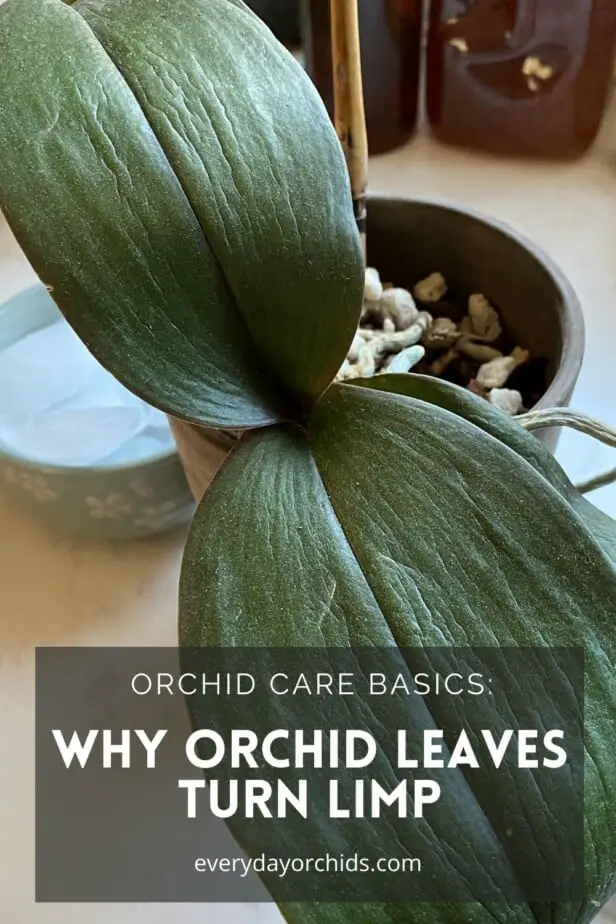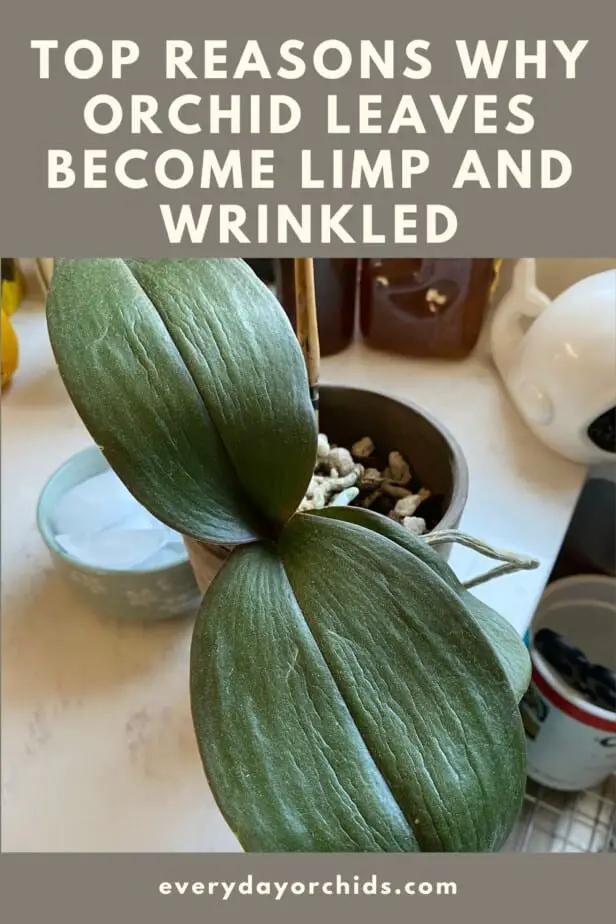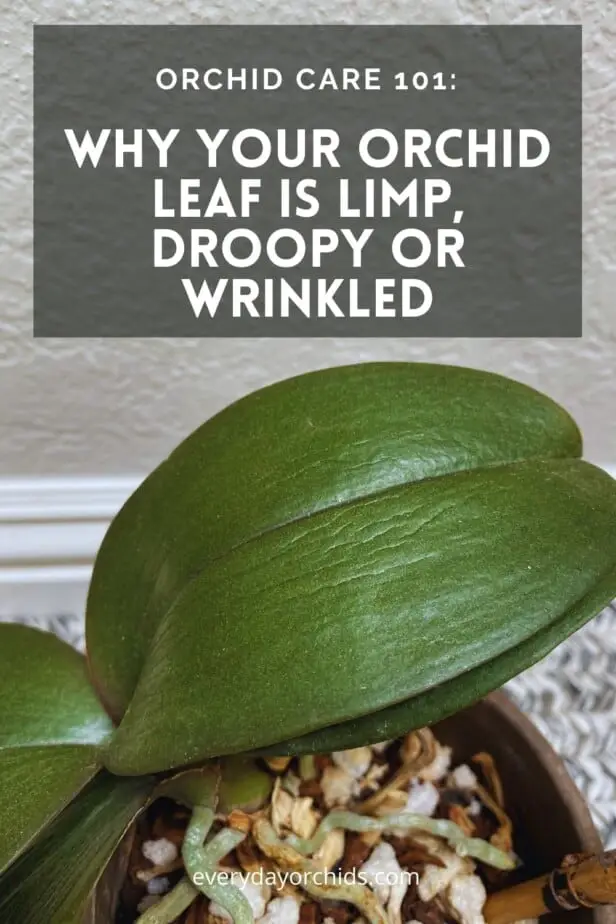Wrinkled, limp and wilted orchid leaves can tell you a lot about the health of your orchid plant. It is your orchid’s way of communicating with you. Normal, healthy orchid leaves are shiny, green, firm and can hold their shape. You should not be able to bend a healthy orchid leaf easily, otherwise you risk breaking or cracking the leaf.
It can be distressing to see your orchid leaves turn from firm to droopy and wilted seemingly overnight. Wilted, limp, and wrinkled orchid leaves are often also dull in color. They are a sign that something is wrong with your orchid plant.
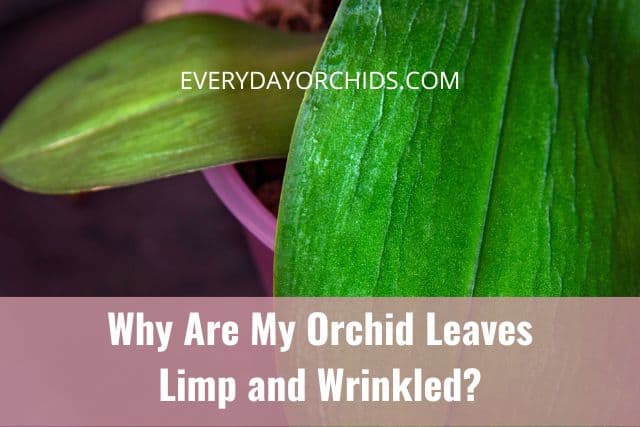
There are a number of reasons why orchid leaves may become limp, wrinkled, or wilted. Orchid leaves can become wilted, limp, wrinkled, or droopy due to watering problems, low humidity, poor root health, temperature extremes, or disease. In many cases, there are changes you can make to your orchid care to fix this problem. In fact, with the right care, wrinkled, wilted orchid leaves can recover.
In this article, I’ll go over the top reasons why your orchid leaves may be limp, wrinkled or wilted. You’ll learn what you can do about it and how you can prevent it from happening again in the future. Keep reading to learn more.
Please note that these links are affiliate links and as an Amazon Associate, I earn from qualifying purchases. Purchases made through affiliate links in this post may generate commissions at no additional cost to you. Use this link for a discounted Amazon Prime trial. Thank you for your support!
Table of Contents
Why Do Orchid Leaves Become Wilted and Wrinkled?
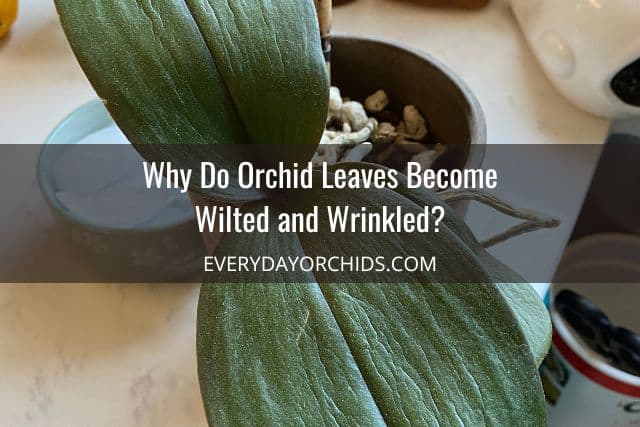
Oftentimes, orchid leaves become wilted and lose their turgor, or firmness, because of a lack of hydration. There is not enough water going into the plant cells to keep them expanded for one reason or another. As a result, the orchid leaf as a whole, becomes limp.
The biggest reasons why orchid leaves can become wilted due to a lack of water, humidity or hydration. I’ll go into more detail about this below.
Wilted Orchid Leaves Due to Inadequate Humidity

Low humidity can cause your orchid leaves to become limp, wrinkled, or wilted.
If you aren’t sure what your home’s humidity levels are, you can always use a hygrometer to find out. The majority of orchids do well with an environment that has a humidity level between 40% to 70%.
If you need to increase humidity levels in your home, you can do this in one of several ways.
Solution: Make a Humidity Tray
You could create a humidity tray and place this under your orchid pots. A humidity tray can be a shallow tray lined with rocks. It is filled partway up the rocks with water. The orchid pots will rest on the rocks.
In order to prevent disease, there should not be any water touching the orchid pots. As the water evaporates, it will add some humidity to the air around the orchid plants.
If you don’t feel like making a humidity tray, you can also just buy one online.
Solution: Use a Cool-Mist Humidifier
Another way to raise humidity levels for your orchid plant is to use a cool-mist humidifier. This is my preferred method.
If you don’t want to leave the humidifier running all day, you can initially try running it for a couple hours and see if that is enough to raise the humidity to optimal levels. You can monitor the hygrometer’s humidity readings to see how long those elevated humidity levels last. Make adjustments as needed.
If you need to run the humidifier longer, keep an eye on the humidity levels using your hygrometer. This will help you ensure that you are reaching optimal humidity levels for your orchid and not overdoing it.
Also, make sure you maintain air circulation around your orchids as well. Humidity without air circulation can lead to mold, fungal infections and mildew growth over time.
Solution: Mist Your Orchids
Lastly, you can mist your orchids to raise the humidity. I talk more about the pros and cons of misting an orchid here.
In my opinion, this is possibly the least effective method, as misting is short-lived. When you do mist your orchid, take care to mist only the aerial roots.
You may be tempted to mist the leaves, since they look wilted and in need of moisture. Don’t do it. Instead, do your best to avoid misting the top of the leaves.
If you mist the leaves, you run the risk of causing crown rot. This is because water droplets can run down the leaves and settle in the crown of the orchid. For similar reasons, you also run the risk of stem rot.
Misting the leaves will also cause water spots on the leaves as the water dries. If the water is contaminated with bacteria, brown rot or brown spot can occur. Getting water on the orchid blooms can also result in petal blight.
Misting mainly serves to moisten the aerial roots and top layer of potting media. At most, it raises humidity levels incrementally and only temporarily.
In addition, keeping the top layer of potting media constantly moist causes the potting media to break down faster and encourages infestation by fungus gnats. This makes misting my least favorite method for raising humidity levels around your orchids.
If you are needing to increase humidity levels for your orchids, you would be better off using a cool-mist humidifier or a humidity tray. You can read more about how to raise humidity levels for orchids here.
Wilted Orchid Leaves Due To Poor Potting Medium Quality
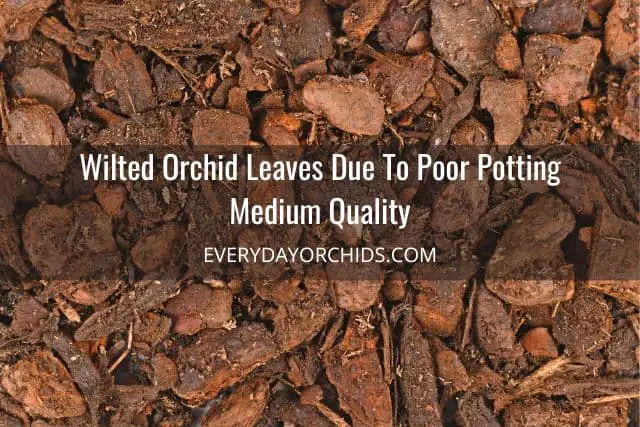
As the potting media starts to decompose or break down, this leads to decreased air circulation and drainage around the orchid roots. This, in turn, can lead to root problems such as root rot.
Root rot will then lead to decreased water uptake and eventually, limp, wilted, wrinkled orchid leaves. If you aren’t sure if your orchid has root rot, check out this guide to signs of root rot in orchids.
Decomposition of the potting media is inevitable and something you will need to keep an eye on. If your orchid’s potting media has started to decompose or break down, you will likely need to repot your orchid.
Generally, most orchids need to be repotted every 1 to 2 years. The exception to this are terrestrial orchids, which can go longer between repottings, about 2 to 3 years.
The quality of the potting medium and the type you choose for your orchid will play a role in how long the potting media lasts. If you’d like to learn more, check out this resource on orchid potting media and find out how to choose the right potting media for your particular orchid.
Solution: Use New Potting Media
To address the problem of decomposing potting media, you will need to repot your orchid and exchange the old potting media for new orchid potting media. Decomposing potting media, or potting media that drains poorly, can lead to root damage, which is our next topic.
Wilted Orchid Leaves Due to Insufficient Water and Root Damage
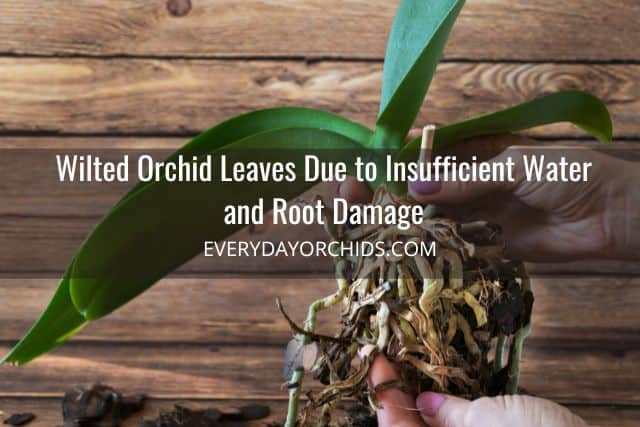
If your orchid leaves start to appear limp and wrinkled, despite regular watering efforts, you will want to check the health of your orchid roots. I outlined the different types of orchid roots here.
Normal, healthy orchid roots should be firm, plump, and have a silvery (dry) or green (just watered) color.
Rotted orchid roots are often mushy and brown or black in color. Overwatering can lead to root rot, which then renders the roots unable to absorb water.
So, even if you are watering your orchid on a regular basis, it will not be able to access or absorb that water since the roots are damaged. If your orchid has root rot, the inability of the roots to absorb water will result in wilted, limp, and wrinkled orchid leaves.
On the flip side, dry and shriveled roots will appear thin, brown, and brittle. If your orchid roots are dry and shriveled and have died due to dehydration, the orchid will not be able to absorb the water. This is true even if you start to water your orchid regularly. Dead roots cannot absorb water.
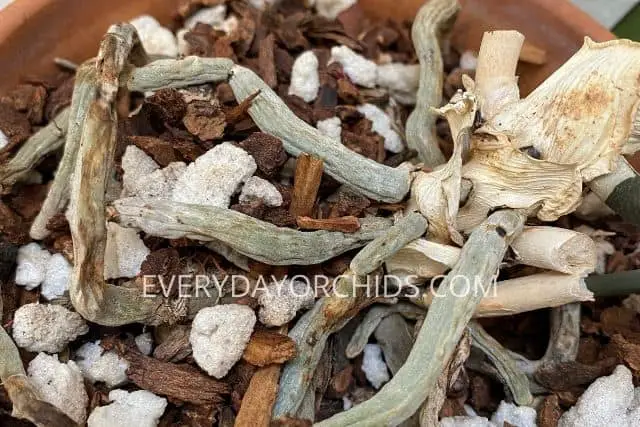
Unfortunately, underwatering orchids often happens as a result of the orchid grower trying to avoid overwatering. In an attempt to avoid root rot and overwatering, newer orchid growers often err on the side of caution and water their orchid less. This can result in dried orchid roots. If left unwatered, dried roots can progress into shriveled, dead roots.
The ice cube watering method, with its uneven watering patterns, will also result in dried, shriveled orchid roots. Unfortunately, poor watering techniques are one of the top reasons why orchids die.
Solution: Repot Your Orchid
To address this, you will need to remove your orchid from the pot and trim off all the dead, rotted or dried up roots. Repot the orchid in new potting media. Going forward, you will need to pay close attention to your watering habits.
If root rot was the cause of the limp and wrinkled orchid leaves, be sure to place your finger in the potting media before you water next time. This will help you determine if you need to water your orchid or not.
If the top two inches of potting media are still damp, then forgo watering for a few more days. Wait until the potting media is dry or nearly dry before you water your orchid.
Generally, most orchids like to be watered every 7 to 10 days, but it is always a good idea to check the potting media before watering.
For more information, read this guide on how to water your orchids. If your orchids use an alternative potting media such as moss, I go over how to water orchids potted in moss here.
Solution: Rehydrate Your Dry Orchid Roots
If the roots are slightly dry but not yet dead, you can try to rehydrate them using a couple different methods. You can use an Epsom salt soak for your orchids.
Alternatively, you can simply soak your orchid roots in water. To do this, fill a shallow basin with some room-temperature water up to the rim of the orchid pots. Allow your orchid pots to soak there for at least ten minutes. After the time is up, be sure you allow the orchid pots to fully drain the excess water.
Whichever method you use to rehydrate your orchid roots, do it in the morning. This will allow ample time for excess water to dry off from your orchid potting media before nightfall. By doing so, you will help prevent root rot in your orchids.
Wilted Orchid Leaves Due to Temperature Extremes

The majority of orchid species cannot tolerate extremely hot or cold temperatures, with some exceptions. There are thousands of different orchid species and temperature tolerance ranges will vary according to the particular orchid you are caring for.
I go over temperature tolerance ranges for some popular terrestrial orchids here, along with general care practices. I also discuss temperature tolerance ranges for various other popular orchid species in my article about outdoor orchids.
Wilted Orchid Leaves Due to Extreme Cold
Orchids exposed to temperatures below their tolerance levels will have cold, chill and frost injuries.
Wilted, limp, lifeless leaves on your orchid are one of the signs of cold injury.
Due to the damage to the plant cells within the orchid leaf, the leaf will also feel soft and squishy. One night at freezing temperatures may not have long-term effects, but extended exposure to cold can lead to damage on your orchid.
Repeated exposure to cold or freezing temperatures will cause the orchid leaves to start to droop and wilt. If the orchid is not brought inside to warmer temperatures, the cold injury will progress and the orchid will eventually die.
Solution: Help Your Orchid Recover From Its Cold Injury
There are a few things you can do to help your orchid recover from extreme cold temperatures and cold injuries.
The first thing you want to do is to bring your orchid inside out of the cold, if you haven’t already. Rather than placing it next to a heater or heat source (a big no-no), you want to allow it to gradually acclimate to the indoor temperature. While your orchid is recovering, try to avoid direct heat and sunlight on your orchid plant.
You will also want to stop watering your orchid for a few days and allow the potting media to dry out. Turn on your cool-mist humidifier and bring the indoor humidity levels to 50% to 70%.
Once you notice growth resuming on your orchid plant, you can safely start watering your orchid again. For more information about how to take care of a cold injury or frost injury in orchid plants, you can read more about orchid care during winter weather.
Wilted Orchid Leaves Due to Extreme Heat
Extremely hot weather can also cause orchid leaves to become limp, wilted and wrinkled. Sometimes this is due to the rapid evaporation of moisture from the potting media, which can lead to dried orchid roots and under hydration.
Solution: Keep Your Orchids Hydrated
In hot weather, keep a close eye on the status of your orchid potting media. Do not let the potting media dry out completely.
During extreme heat waves and high summer temperatures, you will want to keep your orchids shaded, maintain air circulation and water your orchids regularly. You may find that your orchid might need to be watered as frequently as two or even three times a week during extremely hot weather periods.
Wilted and Limp Orchid Leaves Due To Disease and Fungal Infections
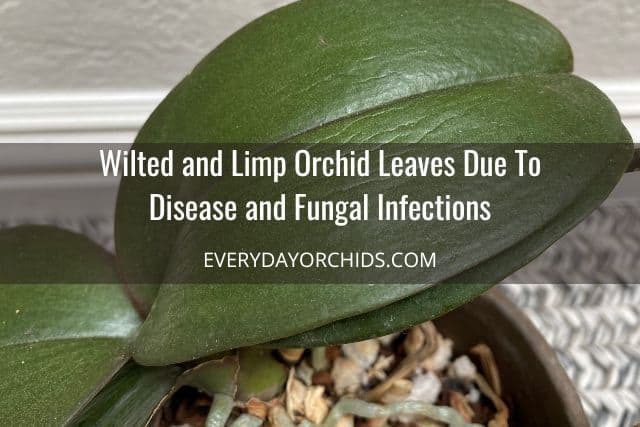
Oftentimes, disease and rot occurs because of improper watering techniques, which in turn causes root rot, mold growth in the potting media, and so on. An orchid plant under stress will be more susceptible to disease and infestations. If your orchid leaves are wilted and limp due to a pathogen or infection, you will need to isolate the infected orchid first and foremost. Then treat the orchid according to the infection.
Wilted Orchid Leaves Due to Root Rot
I went over root rot earlier, when I discussed root damage as one of the causes of wilted, droopy orchid leaves. Know that at its core, root rot is caused by constant exposure of the roots to moisture, which creates a breeding ground for organisms that cause rot.
Wilted Orchid Leaves Due to Black Rot
Black rot is a type of fungal infection that happens when orchids are left in standing water. As the fungus attacks the orchid plant, it will secrete enzymes that start to break down the orchid tissue.
You may initially see black or dark spots scattered throughout your orchid leaves. If left untreated, these spots will grow larger and spread. As the fungus continues to break down the orchid tissue, the leaves lose their structure and become limp and wilted.
If nothing is done to address the black rot infection, the orchid plant will damp off as the stem and leaf tissues rot. Eventually, the orchid plant will die.
If you want to learn more about black rot and how you can treat it, check out this Everyday Orchids guide to fixing top orchid problems.
Wilted Orchid Leaves Due to Crown Rot
Crown rot is unfortunately something most beginner orchid growers will encounter at least once in their lifetime. This is due to improper watering techniques that allow water to settle into the crown of the orchid plant.
Most common in Phalaenopsis and Vanda orchids, crown rot is a fungal infection that spreads rapidly and can cause wilting of the orchid leaves.
As water is left to stagnate in the orchid’s crown, a fungal infection takes hold. As the infection spreads throughout the orchid plant, the orchid leaves will turn yellow, mushy, and limp. The leaves will begin to die and fall off one by one. If left untreated, the orchid’s main stem will eventually succumb to rot and die as well.
Treatment for crown rot is fairly straightforward and involves hydrogen peroxide and cinnamon powder. If you want to learn more, read about crown rot and how you can treat and prevent crown rot in your orchid.
Crown rot can lead to orchid leaves turning limp and wilting. As mentioned above, you will also see the orchid leaves change color. This is a strong indicator that something is going on in your orchid beyond improper watering or damaged roots, and you will need to investigate further.
Can Wrinkled Orchid Leaves Recover?
Unfortunately, orchid leaves that have become limp, wrinkled and wilted will never revert back to their original appearance. The exception to this would be if you caught the leaf damage early and quickly made changes to your orchid care. This would have allowed the orchid leaf to fully recover before permanent damage occurred.
Orchid leaves can become wilted, limp, wrinkled or droopy due to problems with watering, humidity, poor potting media, or disease.
Even if you do address these problems and the orchid recovers, the leaf structure has changed. While the leaf may become stronger and firmer over time with proper hydration and care, you may still see some wrinkles and residual weakness in the leaf.
On the bright side, now that you have addressed these problems, you are ensuring that newer orchid leaves will remain firm and healthy.
Final Thoughts
I’ve gone over the top reasons why orchid leaves may become wilted, limp or wrinkled. A lot of it boils down to watering issues, a lack of humidity in the orchid’s growing environment or root problems.
It may take some time to figure out what is causing your orchid’s wrinkled leaves, but regular, weekly inspections of your orchids will help you catch the problem early.
As long as you take steps to correct what is causing your orchid leaves to turn limp, wrinkled, or droopy, you will be able to save your orchid plant and help it recover.
I hope this article has helped you. As always, happy orchid growing.
If you enjoyed this article, please pin it and share!

